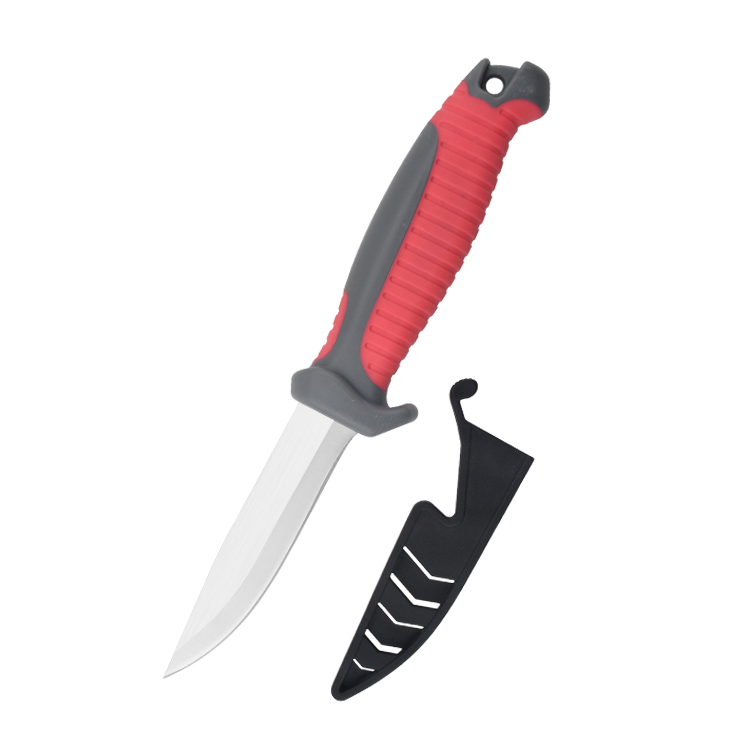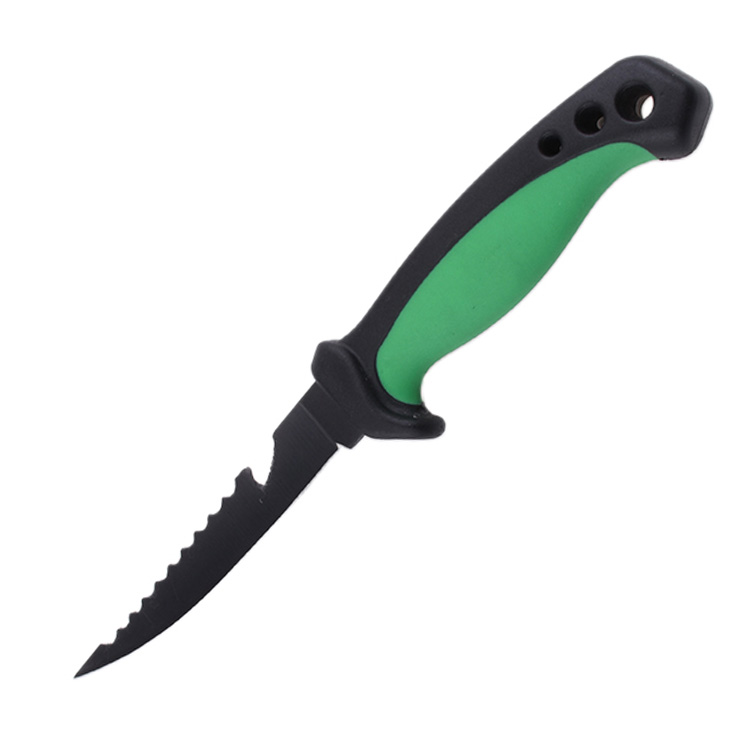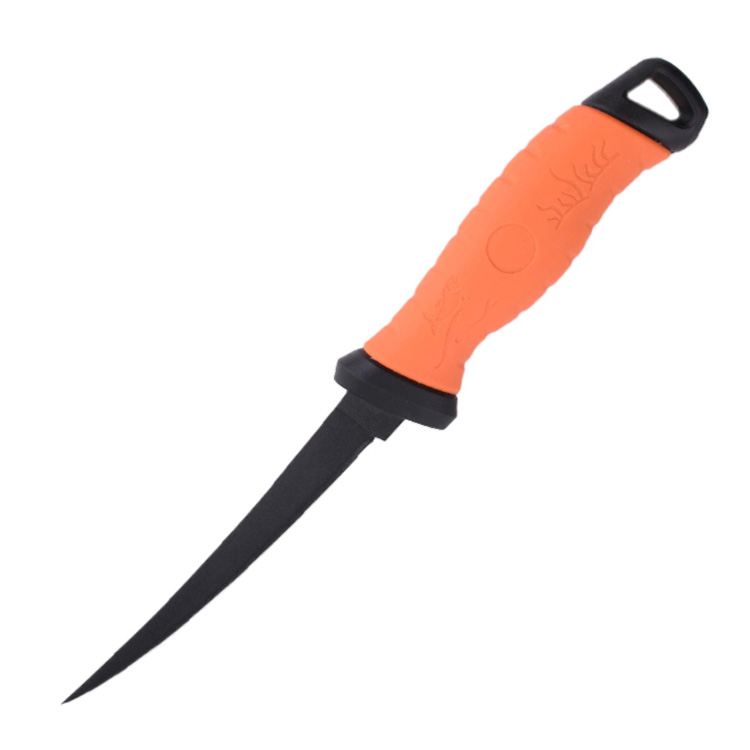Are you tired of using one knife to cut through fish flesh and another to cut through bones? Is the frequent switching bothering you? We will help you find the perfect fillet knife for fish of all sizes and shapes. It may seem simple, but you must consider many aspects before purchasing.
Imagine you’ve just landed a whopper or reeled in a monster at your favorite fishing spot! The fish is now on your cutting or fillet board, and the chances of a beautifully prepared fish fillet on your dinner table are high, thanks to your knowledge and the right tools.
This article is your trusted guide to finding the perfect fillet knife. We’re here to help you choose a structurally strong knife that stays sharp, provides a solid grip, and has a good lifespan. We will also offer tips and a maintenance guide for extending the life of your favorite fillet knife. Let’s begin!
Essential Characteristics of a Fillet Knife
Before we get into the intimate details, it is vital to understand a fillet knife’s fundamental characteristics. The structure and design of a fillet knife make it unique and differentiate it from other knives.
Structure of a Fillet Knife
The distinct feature of a fillet knife is its thin and flexible blade. Manufacturers design them to fillet fish and cut through bones with ease. The average length is between 6 to 11 inches. The knife curves upward with a sharp tip at the end.
Design Features of Typical Fillet Knife
Loads of work goes into designing a fillet knife, as user preference may vary depending on region and culture. Manufacturers keep these aspects in mind while designing a perfect fillet knife. Here are the design aspects to consider:
- Extended tang for better balance and stability
- Finger guard and bolster to protect the finger
- Handle material with a good grip
- Length selection based on maneuverability
- Single or double-bevel-edge
We will discuss these design features in detail later in the blog. To understand what makes a fillet knife unique, let’s examine the difference between a regular kitchen knife and a fillet knife in tabular form.
Fillet Knife vs. Regular Kitchen Knife
| Особенность | Fillet Knife | Regular Kitchen Knife |
| Primary Purpose | Filleting fish (separating flesh from bones and skin) | General purpose chopping, slicing, and dicing of various ingredients |
| Длина клинка | Longer and thinner | Shorter and broader |
| Гибкость лезвия | More flexible for maneuvering around bones | Stiffer for better control and power when chopping |
| Blade Profile | Curved or semi-curved for gliding through flesh | Straight or slightly curved for various cutting tasks |
| Blade Tip | Pointed for precision when separating flesh | More rounded for safety and versatility |
| Материал | Often high-quality, corrosion-resistant steel for maintaining a sharp edge | Varies depending on the knife, but often high-carbon or stainless steel |
| Ручка | Ergonomic design for comfortable grip during long, precise cuts | Variety of handle designs, some prioritizing comfort, others prioritizing control |
| Общий вес | Lighter weight for maneuverability | Heavier weight for chopping power |
Critical Factors in Choosing a Fillet Knife
Now that we know the basics of a fillet knife, we can move into a more in-depth analysis. Here is a detailed analysis of each aspect of the fillet knife:
● Blade Length
The length of the blade determines the size of the fish you are going to fillet. A larger blade can be challenging to master, but filleting a big or small fish is satisfactory once you get the hang of it.
● Flexibility and Blade Maneuverability
Fillet knives primarily have greater flexibility so that they can maneuver around bones. You need a clean cut between the flesh and bones as an expert. A flexible fillet knife can give you that ease of maneuverability but at the cost of stiffness, which can be important for some people who like cutting through bones. Observing the blade’s thickness in the specification gives one an idea of its flexibility. 1.5mm to 2mm blade thickness is common in fillet knives.
● Long Lasting Blade Sharpness
A blunt knife is just a piece of metal! Sharpness is what makes a knife good or bad. We are looking for a knife that can sustain sharpness after multiple cutting sessions. 6Cr13, 3Cr13, 440c, and 420J2 are some materials manufacturers use to make fillet knives. The blade will have sharpness and corrosion resistance depending on the carbon and chromium content. So, study these materials before making a purchase.
● Handle Design for a Solid Grip
Filleting a fish can get messy with slime and blood during cutting. The slippery nature of these substances can lead to a loss of grip that can quickly become an injury. To avoid this, manufacturers use a solid grip with a rugged surface. The handle has a finger guard shaped to prevent fingers from slipping towards the blade.
Selection of Blade Material
The blade is the most vital part of the knife. Selecting a knife involves carefully analyzing the blade characteristics. Many blade materials directly impact the blade’s sharpness and durability. We named some of these blades earlier in the blog. Let’s discuss their distinct features:
1. AUS-8, 420HC
Material Composition: High Carbon Stainless Steel
Sharpness: Can take a very sharp edge due to high carbon content
Durability: Good corrosion resistance
Pros:
- Great price-to-performance ratio
- Provides sharpness and durability
- Sharpening does not require expertise
Cons:
- It may require frequent sharpening
2. 3Cr13
Material Composition: Stainless Steel
Sharpness: Holds the edge for multiple cutting sessions before dulling down
Durability: Can catch rust if not coated or taken care of
Pros:
- Unbeatable price
- Sharpens easily at home
Cons:
- Difficult to retain sharpness
3. X50CrMoV15
Material Composition: German Stainless Steel
Sharpness: Maintains the edge exceptionally well
Durability: Excellent corrosion resistance, moderately durable.
Pros:
- Allows manufacturing thin blades
- Excellent performance for a fillet knife
- Holds the edge for multiple sessions
Cons:
- Difficult to sharpen
- Comparatively brittle to other material
Sharpening and Maintenance of a Fillet Knife
No matter how tough, durable, and corrosion-resistant your knife material is, it still needs care and maintenance. Fillet knives typically have a double bevel edge. The most efficient method is using a grit stone. If your knife is not seriously damaged, grit stones give it the perfect slicing capability. However, other sharpening tools are more accessible.
Sharpening with Grit Stone
It takes some skill to use grit stones to sharpen a knife. However, it is the best method for maintaining a knife edge. Here are the steps for using a grit stone to sharpen knives:
- Prepare the grit stone by soaking it in water for approximately 30 minutes
- Use a 2000 & 5000 Grit Stone. A higher number means a finer edge.
- Place the sharp edge on the coarse stone and lift the other end. The lift should be around the height of two quarters placed flat on the stone surface.
- Start moving in a cutting motion on the stone. Use multiple fingers to hold down the fillet knife and apply pressure on the blade.
- Turn the knife and perform the same motion to sharpen.
- Change to 5000 grit stone and repeat the steps to obtain a perfect sharp fillet knife.
Sharpening with Three Stage Knife Sharpeners
Three-stage knife sharpeners can fix damaged edges and provide a sharp edge, which is ideal for moderate stainless steel knives. The process is simple: slide the blade between the slots from coarse to fine.
- If your knife is damaged or dull, place it in the coarse sharpening slot and slide the blade from tip to grip.
- Switch to the 2nd stage once satisfied and have smooth feedback from the sliding motion in the 1st stage.
- Repeat the sliding motion and use the 3rd stage to sharpen the blade.
Extend the Knifes Lifespan
There are multiple things users can do to maintain the knife and extend its lifespan. The following tips will ensure that your expensive knife doesn’t damage any time soon:
- Avoid dishwashers
- Apply oil to the blade for life extension
- Do not store the knife with other utensils
- Use a sheath when storing in a drawer with other tools
- Regular sharpening
Usage Tips and Safety Guidelines
It’s vital to remain vigilant when using a fillet knife, as the blades are thin and sharp. If you want to stay safe, here are some usage tips to consider:
- Use a fillet knife with a good grip, especially a finger guard.
- Move the blade away from yourself when cutting.
- Keep the blade facing downward when handing someone a knife.
- Try to avoid catching a falling knife. You can always sharpen it afterward, but your health is also essential.
- Store the knife with a sheath to prevent cutting yourself while retrieving it.
Recommended Choices on the Market
There are tons of choices when it comes to fillet knives. However, some stand out due to their quality, performance, affordability, or durability.
Gerber Controller 8″ – SALT
Saltwater fish have more rigid bones and flesh, which can be challenging for an ordinary knife. Gerber offers CONTROLLER 8″ – SALT, excellent saltwater knives with a higher chromium content. Here are the key features of the knife:
Blade Material: 9Cr18MoV
Knife Grip: HydroTread Grip with Finger Choil
Handle Material: Glass-reinforced polypropylene
Shieldon 13.78” Long Fish Fillet Knife ZY-FK49A
When aiming for a budget-friendly knife that holds its sharpness and provides corrosion-resistant properties, then Shieldon is the way to go. Their ZY-FK49A is a нож с фиксированным лезвием with a trailing point design. The blade is 2mm thick and 230mm in length. Here are its main highlights:
Blade Material: 3Cr13
Knife Grip: Bulging Surface with Finger Guard
Handle Material: Thermoplastic Rubber and Polypropylene
Kershaw 7.5″ Narrow Fish Fillet Knife
Kershaw is a respected brand within the fishing community. They provide high-quality products within the mid-range price tag. Their 7.5” Narrow fish fillet knife is famous for its highly flexible blade material. Its corrosion-resistant properties and resharpening capabilities make it a great fishing tool.
Blade Material: 420J
Knife Grip: K-Texture Grip
Handle Material: Glass-filled Nylon with Rubber Overmold
Special Purpose Fillet Knives
There are special-purpose knives that target specific applications. They can be externally power-supplied or offer unique folding capabilities. Here are some of the special-purpose knives:
- Corded Electric Fillet Knives
- Wireless Fillet Knives
- Foldable Fillet Knives
Electric-powered knives may take a little time to get used to, and they quickly get heated over long sessions. In comparison, wireless-powered knives require charging, which can mean downtime for professionals. Foldable knives have the limitation of length. A standard trailing point blade design is the best for filleting fish.
Заключение
Imagine having a restaurant-grade fillet at home! Despite having loads of practice, having the right tools is essential. Finding the perfect fillet knife is where the whole process begins. A substandard knife may need more flexibility to slide over bones and cut through flesh smoothly. So, let’s summarize the critical points to finding the perfect fillet knife:
- Select a blade with corrosion-resistance properties.
- Pick material with the right balance of carbon and chromium for flexibility.
- Look for online reviews on different knives.
- Observe good grip, as it is essential to ensure safety and accurate cutting.
- Consider salt and freshwater knives as per the requirement.
- Double-wedge knives are easier to handle and sharpen.
Shieldon: Your OEM Partner for Top-Shelf Fillet Knives
If you are looking for an original equipment manufacturer (ОЕМ) capable of producing top-shelf fillet knives, Shiledon is the brand. They offer a wide range of knives, including Folding, Fixed-Blade, Hunting, Fishing, Filet, Laguiole, and many more, manufactured with premium-grade material. Their product range comprises premium and budget-friendly options catering to all user preferences.
Their fillet knives are available in all sizes, shapes, and qualities. Whether at home or in a restaurant, their knives will let you cut like a pro in no time!
Часто задаваемые вопросы
Q: How does the blade length of a fillet knife affect cutting?
A: As the blade length increases, the fillet knife’s maneuverability increases. The increase in blade length makes it difficult to handle. When filleting a large fish like bluefish, cod, and mahi, having a 9” or longer blade becomes essential. A short blade is easier to handle and offers better control for small fish.
Q: How do you choose a fillet knife that fits your hand size?
A: The knife handle does not necessarily need to fit entirely into your hand—however, the texture, material, surface finish, and shape of a fillet knife need to have an excellent design to provide a perfect grip. There is lots of mucus or slime on fish, which can be slippery, and handling can become difficult without a good grip.
Q: Can a fillet be sharpened appropriately to maintain its sharpness?
A: Yes, the material of the fillet knife blade determines its sharpness. Two ways to sharpen a fillet knife are using a grit stone or a three-stage sharpening tool. If the material of the fillet knife blade has the right balance of toughness and elasticity, it will maintain its sharpness and provide ease of sharpening at home. 3Cr13 and 9Cr13 are excellent materials for ease of sharpening.
Q: What are the safety precautions when using a fillet knife?
A: Generally, using a fillet knife to cut through fish flesh and bones is a slippery process. So, when using the fillet knife, make sure that your grip is firm and the fish is lying on a non-slippery surface. While cutting, always cut away from yourself to avoid knocking. Also, keep the blade tip facing downwards when handing over the knife.
Q: What are the uses of specially designed fillet knives?
A: Specially designed fillet knives, like ones designed for saltwater fish and freshwater fish, are meant to provide better handling as the flesh of both fishes is different. Similarly, an electrically corded fillet knife makes the process more accessible with a lower force requirement. A wireless fillet knife provides a cordless fish filleting process. A pocket foldable fillet knife provides storage convenience in outdoor activities.








